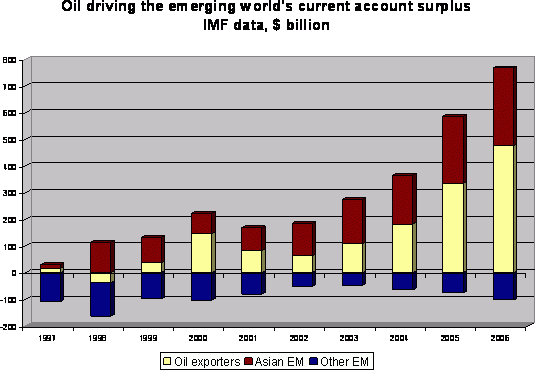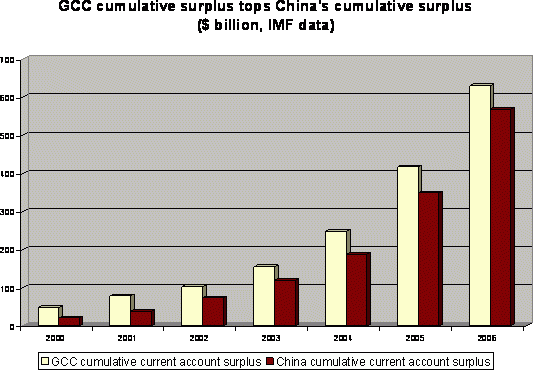Enough on China … let’s talk petrodollars
November 21, 2006 10:30 am (EST)
- Post
- Blog posts represent the views of CFR fellows and staff and not those of CFR, which takes no institutional positions.
More on:
One thing consistently surprises me: how little most folks in the US markets – including folks active in international markets -- know about the growth in reserves of the oil exporters. China, everyone gets. But not Russia and Saudi Arabia. Estimates of oil reserve growth at the Euromoney fx conference in New York were stunningly off (and way on the low side). And there is a lot less talk of petrodollars than Chinese dollars these days.
There are reasons for this. China buys directly from the US broker-dealers. It is on track to buy over $100b or so directly from the broker-dealers this year (as well as building up its short-term claims). No doubt its total purchases are higher.
The oil exporters tend not to buy directly. They buy through intermediaries, build-up bank accounts in London (which help finance London hedge funds and others buying riskier US assets) and invest directly in hedge funds and other money managers. They aren’t as visible a presence, at least in the US.
Russian reserves are up $94.8b through mid-November. Setting the second quarter aside (for seasonal reasons), Saudi Monetary Agency foreign assets are growing by a bit less than $25b a quarter, so its total reserve growth for the year should top $75b. That's real money. The Emirates doesn't report how much it is putting into its various oil investment funds, but $40-50b seems reasonable. And so on.
Some oil exporters are so conservative that they haven’t been a big player in the debt market -- Russia, for example, has a very conservative portfolio of portfolio of short-term agencies and bank deposits. Other oil exporters hold a very diverse portfolio – one that includes equities and emerging market debt, reducing their impact on the US fixed-income market. ADIA (Abu Dhabi’s Investment Authority) is a good example. No doubt some oil exporters also farm out management of some of their portfolio to US and London and other fund managers, effectively financing a lot of “private” market activity.
As a result, it is hard to find oil related flows in the US data (this RGE proprietary paper has the details). It is also hard to find all Chinese flows – but it is easy to find about ½ of them.
Still, it is worth remembering that the Gulf (the GCC countries) will have a current account surplus that is only slightly smaller than China’s surplus this year. Only about ½ of that surplus goes into formal reserves (counting all SAMA foreign assets) – the rest goes into oil investment funds. So GCC reserve growth lags Chinese reserve growth. But if you combine Saudi and Russian reserve growth, it is comparable to Chinese reserve growth … but it also attracts a lot less attention.
Two graphs illustrate the impact of oil exporters on the global balance.
The first comes straight from the IMF. It compares the expected surpluses of the major oil exporting regions (The Middle East, Russia and Africa – think Algeria and Libya as well as Nigeria and Angola) with the expected surpluses of emerging Asia (including the NIEs) and other emerging economies (Eastern Europe/ Latin America). The measure of oil exporters misses Venezuela, so it isn’t perfect … and the IMF’s calculations use an average oil price that looks to be about $5 too high for 2006, so its estimates are likely on the high side for the oil exporters and the low side for Asia.
Enough throat clearing. The picture speaks for itself: oil exporters are currently the dominant source of the emerging world’s current account surplus.

The second graph compares the gulf’s (GCC countries – Saudi Arabia, the Emirates, Kuwait, Qatar, Bahrain and Oman) cumulative current account surplus since 2000 with China’s cumulative surplus. China’s cumulative surplus lags the Gulf’s.

China’s cumulative reserve growth leads the combined growth of GCC reserves and the increase in the GCC’s oil investment funds (at least that portion of the increase that comes from new funds, not capital gains), as China has attracted large (net) capital inflows. And now that China has a $230-240b current account surplus, it is on track to build up its current account surplus more rapidly than the Gulf.
But it is still impossible to make the global current account balance – or to find out how the US has financed its “almost inconceivably large” current account surplus -- without taking into account the oil windfall. But absent more visible flows, lots of folks don’t recognize this.
More on:
 Online Store
Online Store